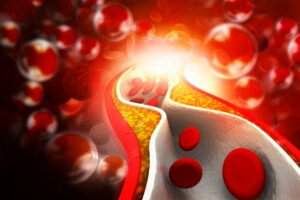Vascular Disease
Vascular disease is any abnormal condition of the arteries or veins. Made up of blood vessels, the vascular system transports blood to and from the heart, providing oxygen, nutrients, and waste removal to every cell in the body. Due to the vital and intricate nature of the vascular system, conditions and diseases can be life threatening, you should consult a specialist if think you may be having a symptom of vascular disease or are at high risk for developing vascular disease. Vascular & Cardiology specialists can help to test and diagnose vascular conditions and diseases using a multitude of new age technology, it is important that you see a specialists as soon as you notice symptoms, as it will give you the best treatment outcome.
Modifiable Risk Factors for Vascular Disease
- Diabetes
- Hyperlipidemia
- Smoking
- High blood pressure
- Obesity
- Lack of exercise

Major Vascular Disease
Coronary artery disease (CAD), also called coronary heart disease, is a condition in which plaque (plak) builds up inside the coronary arteries. These arteries supply your heart muscle with oxygen-rich blood.
Plaque is made up of fat, cholesterol (ko-LES-ter-ol), calcium, and other substances found in the blood. When plaque builds up in the arteries, the condition is called atherosclerosis (ATH-er-o-skler-O-sis).
Plaque narrows the arteries and reduces blood flow to your heart muscle. It also makes it more likely that blood clots will form in your arteries. Blood clots can partially or completely block blood flow.
Arteries have muscular walls to generate pressure that allows oxygen to be delivered. Just like the arteries of the heart itself, the development of high cholesterol, inflammation, and vascular injuries can lead to the development of atheroma (cholesterol-rich plaques) in the walls of the arteries. After years of injury and cholesterol build-up, the arteries can develop significant blockages that decrease blood flow to the distal tissues.
An abdominal aortic aneurysm is a swell or bulging of the artery caused by the weakening of a wall of the aorta in the abdominal region. The bulge or “balloon” is filled with blood, and over time can burst under the stress of normal blood pressure, leading to internal bleeding, hemorrhaging, and extreme pain.
Vascular Conditions & Diseases
An abdominal aortic aneurysm is a swell or bulging of the artery caused by the weakening of a wall of the aorta in the abdominal region. The bulge or “balloon” is filled with blood, and over time can burst under the stress of normal blood pressure, leading to internal bleeding, hemorrhaging, and extreme pain.
Aortic dissection is a separation or tear of the inner layer in the wall of the aortic artery.
Aortoiliac occlusive disease is a blockage in the section of the arterial system, located in the lower abdomen, where the aorta artery splits into the iliac arteries to deliver blood to the lower extremities.
Arm artery disease is a subset of peripheral artery disease, which indicates that the narrowing or blockage of blood flow is located in the arm.
Atherosclerosis (ath-er-o-skler-O-sis) is a disease in which plaque (plak) builds up inside your arteries. Arteries are blood vessels that carry oxygen-rich blood to your heart and other parts of your body.
Chronic venous insufficiency is a chronic condition that occurs when blood flow in the lower extremities fails to continue forward due to a failure or malfunction of the veins and vein valves, resulting in blood pooling.
Deep vein thrombosis is a blood clot formed in a vein considered to be deep in the body such as the thigh or leg.
An Endoleak is a leak in the top or bottom of a stent-graft. While rare, they need to be fixed immediately. The number associated with the type of Endoleak is in accordance with its cause, location, and severity.
Fibromuscular disease is a rare condition that causes an artery to narrow due to abnormal cell growth.
Giant Cell Arteritis is and inflammation of the blood vessels near the scalp, neck, and arms, causing headaches, pain, and vision problems. It is the most common form of vasculitis.
Hyperlipidemia is a condition in which blood that has too many lipids (or fats), such as cholesterol and triglycerides.
Mesenteric Ischemia is the poor delivery and circulation of blood to gastrointestinal organs that over time results in damage.
A peripheral aneurysm is an enlargement or weakened artery wall in any other area than your aorta. It mostly affects the arteries in the legs or neck.
Portal hypertension is an increase in the blood pressure within the veins of the portal venous system. The portal venous system is comprised of the veins which run from the stomach, intestine, spleen, and pancreas which merge into the portal vein, which then branches into smaller vessels and travels through the liver
Pulmonary embolism is a blockage in an artery within the lungs. Usually, the blood clots causing pulmonary embolisms are created by deep vein thrombosis. Blood clots deep in the veins of the lower legs and extremities that break free and travel to the lungs.
Renovascular conditions causes high blood pressure and kidney function impairment when one or both arteries to the kidney narrow, reducing blood and oxygen to the kidney.
A disruption of blood flow causes a stroke to the brain; the lack of oxygen and nutrients quickly results in brain cell damage. Strokes can be caused by blockages in the arteries to the brain due to clots or ruptures.
A thoracic aortic aneurysm is a weakened area of the blood vessel that occurs in the upper area of the aorta.
Thoracic outlet syndrome is a classification of disorders created by compressed blood vessels and nerves in the area of the collarbone that causes numbness in the fingers.
Varicose veins are veins that are swollen and enlarged, generally blue or purple in color. The cause of the inflammation and discoloration is most commonly faulty valves in the veins that regulate blood flow direction.
Vascular trauma is an injury to a blood vessel, including arteries, veins, or any organ returning blood to the heart.
Vasculitis is a broad term for any inflammation of the blood vessels, it occurs when the immune system mistakenly attacks the blood vessels.
Visceral artery aneurysm is an enlarging or ballooning of an artery wall that can burst when the wall thins or blood pressure increases.
